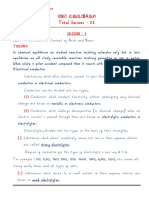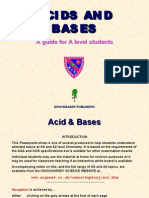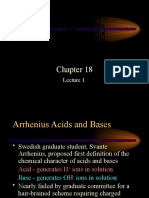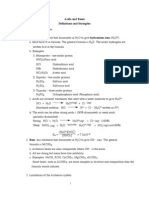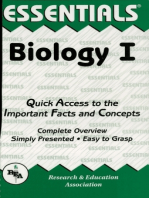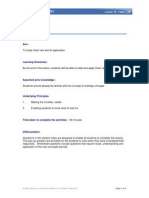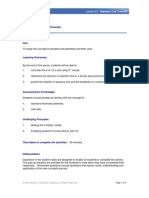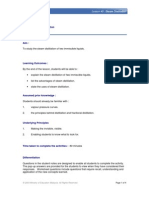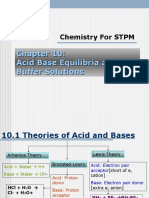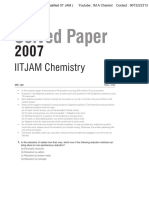0 ratings0% found this document useful (0 votes)
386 viewsLesson Plan: Lesson: Introduction To Ionic Equilibrium
By the end of this lesson, students will be able to : 1. 2. Define an aqueous system. Define acids and bases in terms of a. Arrhenius theory b. Bronsted-Lowry theory c. Lewis theory.
Uploaded by
MarcTnnCopyright
© Attribution Non-Commercial (BY-NC)
Available Formats
Download as PDF, TXT or read online on Scribd
0 ratings0% found this document useful (0 votes)
386 viewsLesson Plan: Lesson: Introduction To Ionic Equilibrium
By the end of this lesson, students will be able to : 1. 2. Define an aqueous system. Define acids and bases in terms of a. Arrhenius theory b. Bronsted-Lowry theory c. Lewis theory.
Uploaded by
MarcTnnCopyright
© Attribution Non-Commercial (BY-NC)
Available Formats
Download as PDF, TXT or read online on Scribd
You are on page 1/ 3
Lesson Plan
Lesson: Introduction to Ionic Equilibrium
Aim :
To study ionic equilibrium.
Learning Outcomes :
By the end of this lesson, students will be able to :
1. define an aqueous system.
2. define acids and bases in terms of :
a. Arrhenius theory
b. Brønsted-Lowry theory
c. Lewis theory.
Assumed prior knowledge :
Students should already be familiar with ionic and covalent compounds.
Underlying Principles
1. Making the invisible, visible.
2. Enabling students to know what to look for.
Time taken to complete the activities : 80 minutes
Differentiation
Questions in the student notes are designed to enable all students to complete the activity.
The pop-up answers are provided for the students to view when they have considered their
responses. Worksheet questions include questions that require recall, understanding and
application of the new concepts learned.
© 2003 Ministry of Education Malaysia. All Rights Reserved. Page 1 of 3
Development of Lesson :
No. Steps Strategy Resources
1 Set Induction. • Teacher to get students to state the
(Ascertaining prior conditions needed for reactions to occur.
knowledge and
introducing lesson • Teacher to introduce lesson objectives for
topic for the day). the day.
2 Student Activity Teacher to go through Activities 1 - 4 • Courseware
with the students.
• Activity 1 : The aqueous system.
Students get to investigate how aqueous
solutions are formed from ionic and
covalent compounds.
• Activity 2 : Arrhenius theory
Students are introduced to the Arrhenius
definitions of acids and bases.
• Activity 3 : Brønsted-Lowry theory
Students are introduced to the Brønsted-
Lowry definitions of acids and bases.
They also learn how to identify the acid-
base conjugate pairs.
• Activity 4 : Lewis theory
Students are introduced to the Lewis
definitions of acids and bases.
3 Evaluation • Students to answer questions in the • Worksheet
student worksheet on their own.
4 Extension activity • Students to go through the extension • Websites
activities on their own. • Reference
books.
© 2003 Ministry of Education Malaysia. All Rights Reserved. Page 2 of 3
Worksheet answers
1. Acid – base system
1.1 a. NH3 + H2O NH4+ + OH–
base acid c.a c.b
b. HNO3 + OH– NO3– + H2O
acid base c.b c.a
c.a = conjugate acid
c.b = conjugate base
1.2 a. OH–(aq) + H+(aq) H2O(l)
b. HSO3–(aq) + H+(aq) H2SO3(aq)
1.3 a. HCO2H(aq) H+(aq) + HCO2–(aq)
b. H2O(l) H+(aq) + OH–(aq)
1.4 a. BF3 – acid, electron pair acceptor.
NH3 – base, electron pair donor.
b. H+ – acid, electron pair acceptor.
OH– – base, electron pair donor.
1.5 An acid ionises in water to produce H+ ions. A base ionises in water to produce
OH− ions.
HCl is an Arrhenius acid.
NaOH is an Arrhenius base.
© 2003 Ministry of Education Malaysia. All Rights Reserved. Page 3 of 3
You might also like
- Let's Review Regents: Living Environment Revised EditionFrom EverandLet's Review Regents: Living Environment Revised EditionNo ratings yet
- Chem106 - Chapter16- 13th November 2024No ratings yetChem106 - Chapter16- 13th November 202455 pages
- Biochem-Chapter 1 - Background in BiochemistryNo ratings yetBiochem-Chapter 1 - Background in Biochemistry8 pages
- Chapter 3 - Concept of Acid-Base NeutralisationNo ratings yetChapter 3 - Concept of Acid-Base Neutralisation58 pages
- Acids and Bases: Faculty: LH 171 Course Code: CHEM 1101No ratings yetAcids and Bases: Faculty: LH 171 Course Code: CHEM 110111 pages
- The Mcgraw-Hill Companies, Inc. Permission Required For Reproduction or DisplayNo ratings yetThe Mcgraw-Hill Companies, Inc. Permission Required For Reproduction or Display25 pages
- Making Physics Fun: Key Concepts, Classroom Activities, and Everyday Examples, Grades K?8From EverandMaking Physics Fun: Key Concepts, Classroom Activities, and Everyday Examples, Grades K?8No ratings yet
- Lesson Plan: Lesson: Uses of ElectrolysisNo ratings yetLesson Plan: Lesson: Uses of Electrolysis3 pages
- Lesson Plan: Lesson: Acid-Base TitrationNo ratings yetLesson Plan: Lesson: Acid-Base Titration4 pages
- Lesson Plan: Lesson: Standard Cell PotentialNo ratings yetLesson Plan: Lesson: Standard Cell Potential4 pages
- Lesson Plan: Lesson: Colligative Properties of SolutionsNo ratings yetLesson Plan: Lesson: Colligative Properties of Solutions3 pages
- Lesson Plan: Lesson: The Base Dissociation ConstantNo ratings yetLesson Plan: Lesson: The Base Dissociation Constant4 pages
- Lesson Plan: Lesson: Le Chatelier's Principle (II)No ratings yetLesson Plan: Lesson: Le Chatelier's Principle (II)4 pages
- Lesson Plan: Lesson: K and K For Heterogeneous SystemNo ratings yetLesson Plan: Lesson: K and K For Heterogeneous System4 pages
- Lesson Plan: Lesson: Le Chatelier's Principle (I)No ratings yetLesson Plan: Lesson: Le Chatelier's Principle (I)4 pages
- Lesson Plan: Lesson: For Homogeneous SystemNo ratings yetLesson Plan: Lesson: For Homogeneous System5 pages
- Lesson Plan: Lesson: For Homogeneous SystemsNo ratings yetLesson Plan: Lesson: For Homogeneous Systems7 pages
- Lesson Plan: Lesson: First and Second Order ReactionNo ratings yetLesson Plan: Lesson: First and Second Order Reaction6 pages
- Lesson Plan: Lesson: Zero Order ReactionNo ratings yetLesson Plan: Lesson: Zero Order Reaction4 pages
- 12th Chemistry EM Important Questions English Medium PDF Download100% (1)12th Chemistry EM Important Questions English Medium PDF Download4 pages
- Rate of Reaction Sodium Thiosulphate and Hydrochloric Acid Coursework100% (1)Rate of Reaction Sodium Thiosulphate and Hydrochloric Acid Coursework4 pages
- Chloromethylation - Benzene Trioxane Zncl2 HCLNo ratings yetChloromethylation - Benzene Trioxane Zncl2 HCL7 pages
- ICSE CLASS 10 ACIDS,BASES,SALTS PAGE-WISE YEAR QUESTIONS QUESTIONS (VIRAF DALAL BOOK)No ratings yetICSE CLASS 10 ACIDS,BASES,SALTS PAGE-WISE YEAR QUESTIONS QUESTIONS (VIRAF DALAL BOOK)10 pages
- Kinetics of Chlorohydrination of Allyl Chloride: G. S. SharifovNo ratings yetKinetics of Chlorohydrination of Allyl Chloride: G. S. Sharifov5 pages
- (Template) SNC1L - 2L Final Chemistry AssignmentNo ratings yet(Template) SNC1L - 2L Final Chemistry Assignment5 pages
- Cambridge IGCSE: Combined Science 0653/21No ratings yetCambridge IGCSE: Combined Science 0653/2116 pages
- Acid Base Equilibria and Buffer SolutionsNo ratings yetAcid Base Equilibria and Buffer Solutions27 pages
- Enzymatic Assay of XYLANASE (EC 3.2.1.8) PrincipleNo ratings yetEnzymatic Assay of XYLANASE (EC 3.2.1.8) Principle4 pages
- Determining The Partition Coefficients by Potentiometric TitrationsNo ratings yetDetermining The Partition Coefficients by Potentiometric Titrations7 pages
- Tutorial Acid and Alkalinity FCH 212 23.12No ratings yetTutorial Acid and Alkalinity FCH 212 23.123 pages
- Isolation and Hydrolysis of Casein From MilkNo ratings yetIsolation and Hydrolysis of Casein From Milk8 pages

















